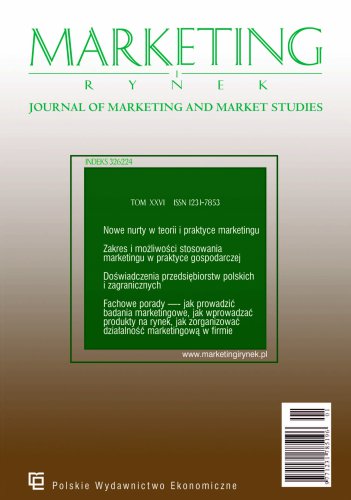The Wagner's Law as a mirror picture of market failures?
The main aim of this paper is to present theoretical concept of Wagner's Law of Increasing State Activity (WL) in a broader context of his views on role of the state and subordinating economy to political and military goals of the state. In majority of research works published the area of his political views and influence on economic policy of the state is not presented. It is also important to notice that narrow analysis focused on comparison between economic growth and budgetary or governmental spending may not necessarily lead to concluding whether the WL is confirmed or not in particular countries. Some parts of public expenditure can be invisible and hard to count, like for instant tax exemptions and remissions. In order to demonstrate the complexity of the discussed issues and the ambiguity of conclusions drawn from the available data, this study uses descriptive statistics, which was accompanied by an analysis of less "conventional" literature describing the career and political views of Adolf Wagner, which so far has been largely omitted in studies focusing on attempts to verify actuality of these rather narrowly understood theses formulated over 140 years ago. Analysis of available statistical data and observations from the literature, presented in this paper, due to the increasing number and variety of publications falling within the discussed issue, is incomplete and requires further analysis.
References
References/Bibliografia
Aranjo, J. T. (1993). The government sector in Kaldor–Pasinetti models of growth and income distribution. Journal of Post Keynesian Economics, 15(2), 211–228. https://doi.org/10.1080/01603477.1992.11489935
Atkinson, A. B.,& Stiglitz, J. E. (1980). Lectures on public economics. London, New York: McGraw–Hill.
Blavatsky, E. (2012). Wagner's Law, the Armey–Rahn Curve, and the Paradox of Wealth. Problems of Economic Transition, 54(12), 40–54. https://doi.org/10.2753/PET1061-1991541203
Baumol, W. J. (1967). Macroeconomics of unbalanced growth: The anatomy of urban crisis. The American Economic Review, 57, 415–426.
Bovenberg, A. L. (1993). Investment promoting policies in open economies. The importance of intergenerational and international distributional effects. Journal of Public Economics, 51, 3–54. https://doi.org/10.1016/0047-2727(93)90003-C
Clark, E. A. (1940). Adolph Wagner: From National Economist to National Socialist. Political Science Quarterly, 55(3). https://doi.org/10.2307/2144096
Frey, B. (1985). Are natural limits to the growth of government? In F. Forte & A. Peacock. (Eds.), Public Expenditure and Government Growth (pp. 101–131). Oxford: Basil Blackwell.
Friedman, M. (1992). Money Mischief. Chicago: Jovanovich.
Gemmell, N. (1993). Wagner's Law and Musgrave`s hypothesis. In N. Gemmell, The growth of the public sector. Theories and international evidence (pp. 103–120). Aldershot and Vermont.
Goffman, I. J. (1972). Wagner`s Law. In B. S. Sahni (Ed.), Public expenditure analysis. Selected readings. Rotterdam University Press.
Gramlich, E. M. (1981). Benefit–Cost Analysis of Government Programs. London.
Hanusch, H. (Ed.). (1982). Public Finance and the Quest of Efficiency, proceedings of the 38th Congress of the International Institute of Public Finance. Detroit: Wayne State University Press.
Heald, D. (1983). Public expenditure. Oxford.
Jaén–Garcia, M. (2018). Wagner's Law: A Revision and a New Empirical Estimation. Hacienda Pública Espanola/Review of Public Economics, 224(1), 13–35. https://doi.org/10.7866/HPE-RPE.18.1.1
IMF (1993). World Economic Outlook, May 1993. Washington DC.
Kau, J. B., & Rubin, P. H. (1981). The size of government. Public Choice, 37(2), 261–274. https://doi.org/10.1007/BF00138246
Malik, A. S., & Schwab, R. M. (1991). The economics of tax amnesties. Journal of Public Economics, 46, 29–50; https://doi.org/10.1016/0047-2727(91)90063-8
Lynde, C., & Richmond, J. (1992). The role of public capital in production. The Review of Economics and Statistics, February, (1), 37–43. https://doi.org/10.2307/2109540
Meade, J. E. (1966a). Private and social costs and benefits. A note on terminology. The Economic Journal, 76, 153. https://doi.org/10.2307/2229070
Meade, J.E. (1966b). The outcome of the Pasinetti process: a note. The Economic Journal, 76, 161–165. https://doi.org/10.2307/2229072
Musgrave, R. A. (1972). A multiple theory of the public household. In B. S. Shani (Ed.), Public expenditure analysis. Selected readings. Rotterdam University Press.
Pasinetti, L. L. (1966). New results in an old framework. Comments on Samuelson and Modigliani. Review of Economic Studies, 33, 303–306. https://doi.org/10.2307/2974426
Peacock, A. (1976). The economic analysis of government and related themes. Oxford.
Steedman, I. (1972). The state and the outcome of the Pasinetti process. The Economic Journal, 82, 1387–1395. https://doi.org/10.2307/2231318
Stiglitz, J. E. et al. (1990). The economic role of the state. Oxford.
Szlichciński, K. (2009). Prawo Wagnera po ponad stu latach — wzrost czy zmniejszenie wydatków publicznych motorem wzrostu gospodarczego? Ekonomia i Prawo, 5, 75–83. https://apcz.umk.pl/czasopisma/index.php/EiP/article/view/EiP.2009.005
Wagner, A. (1883). Finanzwirtschaft, 2nd edition (3rd edition 1890). Leipzig, partly translated and reprinted in R. A. Musgrave, & A. Peacock (Eds.) (1958). Classics in the theory of public finance. London.

